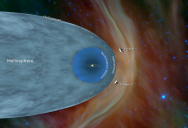The Strange Happenings On The Edge Of Interstellar Space
by Trisha Leigh
When you hear about weird things happening in space, you probably harken back to all of the best science fiction novels you’ve ever read.
This isn’t quite that, but it is interesting nonetheless.
Humans have been able to reach interstellar space, which is the boundary between our solar system and what comes next, twice.
The Voyager 1 and 2 probes have each been traveling in space for over 45 years and have crossed the termination shock and heliopause a couple of times in the past decade.

Image Credit: NASA
There is new research showing that the boundaries are unexpectedly wrinkled, whereas they’ve previously been assumed to be smooth.
NASA’s IBEX (Interstellar Boundary EXplorer) orbits Earth and also tracks changes at the edge of the solar system.
A particular event in 2014, in which the pressure of the solar wind increased by 50%, gave scientists a unique set of data.

Image Credit: NASA
It showed that the wave of particles reached the heliopause in 2015, creating ripples over 900 million miles of space.
Particles were reflected back and forth between the termination shock and heliopause, the effect so bold that the heliopause itself moved forward 460 million miles compared to its previous position.

Image Credit: NASA
Although scientists were already aware that the boundary between the Sun and the rest of the galaxy changed in size every 11 years or so, this data and resulting study shows that the changes could be more complex than anyone realized.
NASA is launching the Interstellar Mapping and Acceleration probe in 2025, which will hopefully provide more insight into the matter.
Categories: NATURE/SPACE
Tags: · heliosphere, intersteller space, NASA, top




